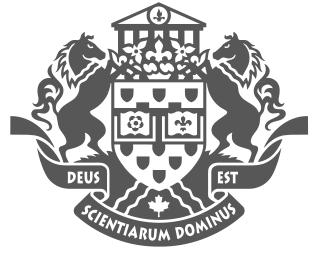
The University of Ottawa, often referred to as uOttawa or U of O, is a bilingual public research university in Ottawa, Ontario, Canada. The main campus is located on 42.5 hectares directly to the northeast of Downtown Ottawa across the Rideau Canal in the Sandy Hill neighbourhood.
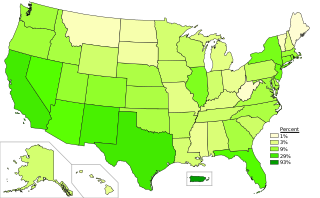
Spanish is the second most spoken language in the United States. Over 41 million people aged five or older speak Spanish at home. Spanish is also the most learned language other than English, with about six million students. Estimates range from 41 million to over 50 million native speakers, heritage language speakers, and second-language speakers. There is an Academy of the Spanish Language located in the United States as well.

Franco-Ontarians are Francophone Canadians that reside in the province of Ontario. Most are French Canadians from Ontario. In 2016, the Government of Ontario calculated that there are approximately 622,415 francophones residing in the province. The majority of Franco-Ontarians in the province reside in Eastern Ontario, Northeastern Ontario, and Central Ontario, although small francophone communities may be found in other regions of the province.
The Charter of the French Language, also known in English as Bill 101, Law 101, or Quebec French Preference Law, is a law in the province of Quebec in Canada defining French, the language of the majority of the population, as the official language of the provincial government. It is the central legislative piece in Quebec's language policy, and one of the three statutory documents Quebec society bases its cohesion upon, along with the Quebec Charter of Human Rights and Freedoms and the Civil Code of Quebec. The Charter also protects the Indigenous languages of Quebec.

A Gaelscoil is an Irish language-medium school in Ireland: the term refers especially to Irish-medium schools outside the Irish-speaking regions or Gaeltacht. Over 50,000 students attend Gaelscoileanna at primary and second-level on the island of Ireland. Additionally, more than 13,000 students are receiving their primary and second level education through Irish in the Gaeltacht. Gaelscoileanna and Irish-medium schools in the Gaeltacht are supported and represented by Gaeloideachas and An Chomhairle um Oideachas Gaeltachta & Gaelscolaíochta or COGG in the Republic of Ireland and by Comhairle na Gaelscolaíochta in Northern Ireland.
The Official Languages Act is a Canadian law that came into force on September 9, 1969, which gives French and English equal status in the government of Canada. This makes them "official" languages, having preferred status in law over all other languages. Although the Official Languages Act is not the only piece of federal language law, it is the legislative keystone of Canada's official bilingualism. It was substantially amended in 1988. Both languages are equal in Canada's government and in all the services it controls, such as the courts.
The Royal Commission on Bilingualism and Biculturalism was a Canadian royal commission established on 19 July 1963, by the government of Prime Minister Lester B. Pearson to "inquire into and report upon the existing state of bilingualism and biculturalism in Canada and to recommend what steps should be taken to develop the Canadian Confederation on the basis of an equal partnership between the two founding races, taking into account the contribution made by the other ethnic groups to the cultural enrichment of Canada and the measures that should be taken to safeguard that contribution".
This article presents the current language demographics of the Canadian province of Quebec.
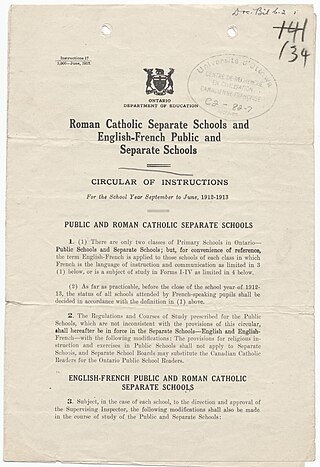
Regulation 17 was a regulation of the Government of Ontario, Canada, designed to limit instruction in French-language Catholic separate schools. The regulation was written by the Ministry of Education and was issued in July 1912 by the Conservative government of premier Sir James P. Whitney. It forbade teaching French beyond grade two in all separate schools.
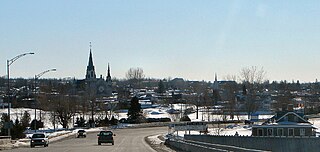
Hawkesbury is a Franco-Ontarian city in Prescott-Russell county in Eastern Ontario, Canada. The vast majority of its 10,550 inhabitants are francophone.
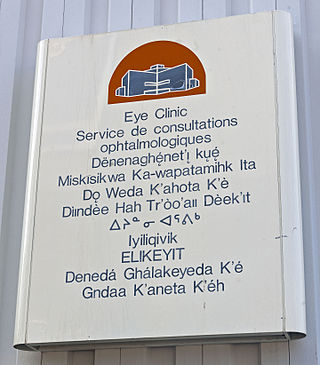
A multitude of languages have always been spoken in Canada. Prior to Confederation, the territories that would become Canada were home to over 70 distinct languages across 12 or so language families. Today, a majority of those indigenous languages are still spoken; however, most are endangered and only about 0.6% of the Canadian population report an Indigenous language as their mother tongue. Since the establishment of the Canadian state, English and French have been the co-official languages and are, by far, the most-spoken languages in the country.

The official languages of Canada are English and French, which "have equality of status and equal rights and privileges as to their use in all institutions of the Parliament and Government of Canada," according to Canada's constitution. "Official bilingualism" is the term used in Canada to collectively describe the policies, constitutional provisions, and laws that ensure legal equality of English and French in the Parliament and courts of Canada, protect the linguistic rights of English- and French-speaking minorities in different provinces, and ensure a level of government services in both languages across Canada.

French immersion is a form of bilingual education in which students who do not speak French as a first language will receive instruction in French. In most French-immersion schools, students will learn to speak French and learn most subjects such as history, music, geography, math, art, physical education and science in French.

Section 16.1 of the Canadian Charter of Rights and Freedoms guarantees equality between English-speaking and French-speaking residents of New Brunswick. Enacted in 1993, it is the most recent addition to the Charter.
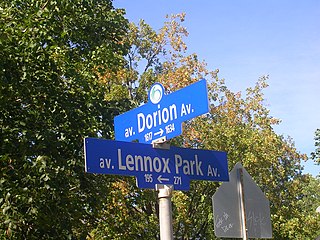
Ottawa offers municipal services in English and French but is not officially bilingual, despite a December 2017 bill intent on requiring the designation.

A bilingual sign is the representation on a panel of texts in more than one language. The use of bilingual signs is usually reserved for situations where there is legally administered bilingualism or where there is a relevant tourist or commercial interest. However, more informal uses of bilingual signs are often found on businesses in areas where there is a high degree of bilingualism, such as tourist venues, ethnic enclaves and historic neighborhoods. In addition, some signs feature synchronic digraphia, the use of multiple writing systems for a single language.
Because the country contains two major language groups and numerous other linguistic minorities, in Canada official languages policy has always been an important and high-profile area of public policy.
Charles Castonguay is a retired associate professor of Mathematics and Statistics at the University of Ottawa.

Shana Poplack, is a Distinguished University Professor in the linguistics department of the University of Ottawa and three time holder of the Canada Research Chair in Linguistics. She is a leading proponent of variation theory, the approach to language science pioneered by William Labov. She has extended the methodology and theory of this field into bilingual speech patterns, the prescription-praxis dialectic in the co-evolution of standard and non-standard languages, and the comparative reconstruction of ancestral speech varieties, including African American vernacular English. She founded and directs the University of Ottawa Sociolinguistics Laboratory.
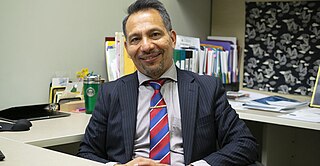
Martin Guardado is a Salvadorian-born Canadian sociolinguist. He is currently a professor of sociocultural linguistics and applied linguistics at the University of Alberta. His research focuses on heritage language socialization and teaching English as a second language. He is noted for his work on heritage language socialization and for recommending that heritage languages need to be studied multidimensionally as well as from macro and micro perspectives. His recent and current research respectively examines the experiences of Japanese-Canadian mothers in mixed language families in Montreal and the characteristics of mixed language parents across a number of linguistic groups in Alberta.













